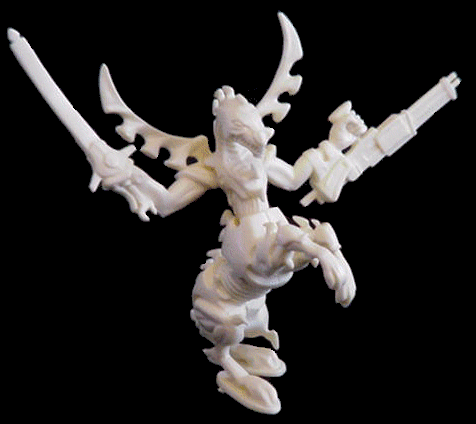
|
|
| 2 Players | 1-3 hours |
|
Concept: Two armies (circa A.D. 1800) meet on the battlefield -- Both armies have artillery, cavalry, infantry and guerrillas. |
|
|
Gameplay: Both players begin with an army of 40 units. The board is set up between them with a partition in place. Players position their pieces in the starting formations: all pieces must start behind a colored line. Once set up, the partition is removed and normal turn movement begins. Movement is played "simultaneously" in "days." On each day a player may move up to 12 units. Each unit's move is written down on a pad -- using the board's coordinate system the starting location and the ending location are noted. After both players have written down their movements for a day, they exchange pads. The pieces are moved by you as your opponent reads them off of your written list. An illegal move will cause the unit(s) involved not to move at all. Pieces may move the following amounts:
Movement is a combination of horizontal and vertical steps -- diagonal moves count two. Height of the space on the board does not affect movement. Units may jump over any other units without affecting them (friend or enemy!) After the pieces have been moved for a given day, casualties are assessed. If there are two units in the same space (one from each player) then players check the piece types and the board to determine which unit is eliminated.
There are three different divisions of infantry and cavalry. You'll have to play the game to see how these interact with each other. After the casualties have been assessed, the artillery phase begins. All enemy units surrounding the artillery are removed if they are within range of the artillery, except for guerrillas. The range of the artillery is determined by the height (altitude) difference of the spaces on the board. If the enemy unit is above the artillery, it is safe. If the unit is at the same height, the range of the artillery is one, if it is one level below the artillery, the range is two, and if it is two levels below the artillery the range is three. The game ends when a general is removed. After the artillery has fired, if the generals are still in play, players write down their next day's movements and repeat the turn cycle. |
|
|
Winning Conditions:
|
|
|
Our Opinion:
The Zombie reviewers don't typically like to play war games. It's not that we don't respect the genre, but we all get tired when a game gets overly serious -- this war game is no exception to that opinion. It is a pure strategy game. If you make a mistake in your strategy, you will most likely lose the game. It's very serious and cerebral. But, this game in particular is a good game to play. "Field Command" starts both players out with identical armies. Both players also start with a map that is identical -- half of the map is a mirror image of the other side. Like chess, you must plan and maneuver your army, you must sacrifice occasionally, and you must be willing to control important sections of the board. The setup of the game will remind most players of Stratego. Deployment of your forces in secret is the first difference in strategies that players must cope with. After the battlefield is exposed, however, the similarities to Stratego end. From here the game plays more like chess. The start of the game is difficult because you have 40 units and are only allowed to move 12. There is also a limited amount of free space on the board, so casualties are expected. As one would expect, the artillery units are incredibly important, and proper usage of them is required to win. The game is well designed and all of the rules fit on one side of the partition board: simple, brief and effective rules. We didn't experience any major loopholes in the rules. This game is a good strategy game. If you are losing, you feel frustrated, but you have enough possibilities open to you that you can entertain the thought of playing again. It is a long game, and can feel slow at times -- especially if one opponent over-thinks every move. It is a good two player game for a strategy enthusiast -- a casual gamer may not like it as it is a heavily planned game that doesn't rely much on luck. One final note, the Zombies did like the different figurines used for the units in the game, it was a nice touch to have identifiable units based on the figurine. For a self published game, this one certainly has class. |
|
|
Where to buy: Special order only... the box says to call this phone number: 1-800-849-8200. |
|
 Other Reviews Other Reviews
|
Zombie Main page
|